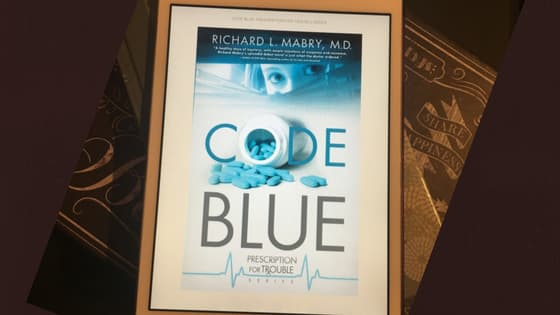I recently reread Richard L. Mabry’s book Code Blue.
It is a Christian medical mystery with a little romance thrown in. Dr. Cathy Sewell returns to her hometown of Dainger, TX, after breaking off her engagement. Moving from the big city back to her hometown proves “daingerous” when Cathy begins to suspect someone wants to run her out of town. Or is she just being paranoid?
As Cathy’s past relationships and experiences haunt her, she begins to question her mental stability. Her struggle to trust God comes to the forefront as her list of suspects grows. As she tries to keep her floundering medical practice afloat, she must juggle the advances of two men in her life.
Why should you read it? I’m glad you asked.
1. It is easy reading. If you are looking for something to read on a vacation or at night when you are winding down, this is a good choice. It won’t require you to take notes but will still keep you interested enough to turn the page.
2. It will hold your interest. Like a typical “whodunit,” this book will keep you turning the pages to figure out if Dr. Cathy Sewel is paranoid of if someone truly is out to get her.
3. You might learn a little something about medicine. Dr. Mabry infuses the story with his extensive medical knowledge, making the reader feel as though she has an “inside scoop” on the happenings of the medical field.
4. BONUS!! (because we all like a freebie) Although this book is one of four in the Prescription for Trouble series, each book is self-contained. That means you can pick up any of the books in the series and begin reading because they don’t overlap in characters or settings. It also means that, by reading one of the books, you aren’t necessarily committing to reading three more books if that type of commitment overwhelms you.
Now for the nitty gritty
- Overall, the story is enjoyable. I found myself excited to see what would happen next. There are some minor story problems, including a few loose ends, some grammatical and editorial issues, and some medical terminology and explanations that are a bit confusing, but none of these interfere with the reader’s understanding or enjoyment of the story. (Also, in the interest of full disclosure, I read the Kindle edition, so some of these issues may not be present in a printed edition.)
- The author includes some thought-provoking discussion questions at the end, which allow the reader to analyze the story in a way she might not have previously.
I will leave the links to the four book in the Prescription for Trouble series here:
SPOILER ALERT
(do not read past this point if you plan to read the book. After you have read the book, come back to this post and let me in on your impressions.)
The end of the story is foreshadowed in the first scene. As Cathy finds herself in danger, Will Kennedy, her high school sweetheart, takes the role of her white knight. Will is patient with Cathy throughout the story and never pressures her to accept him, yet every time Cathy is in trouble, Will is there to rescue her. At one point, she even moves in with his parents after her apartment is burned. Will’s parents, the pastor and pastor’s wife depicted in the story, are generous, attentive hosts, and patiently allow Cathy to come to her own conclusions about God and their son.
The town of Dainger plays the role of another character in the story. In fact, it is the character that ties all of the characters together. Life in a small town can be a challenge as news, good news and disturbing news, travels at lightning speed. But when it seems like everyone in town has a reason to hate you, the name “Dainger” takes on a whole new meaning.
A major theme of the story is guilt. Several characters battle the guilt of sins either of commission or omission. Cathy carries guilt about her parents’ deaths, her past relationships, and her inability to make ends meet in her medical practice. Other characters choose to blame others rather than see how their situation is a direct result of their own choices. One character carries a weight of guilt that has driven her to take antidepressants and attempt suicide. Because guilt plays an important role in the story, the themes of repentance, forgiveness, and restoration are also very prominent.
The book has a Sherlockian plot twist at the end, leaving the reader feeling like she was working without all of the information. Though there were hints dropped along the way, the end came as a surprise. The author did a good job of withholding just enough to keep the reader guessing. So don’t fall for first impressions; they are deceiving!!






0 Comments